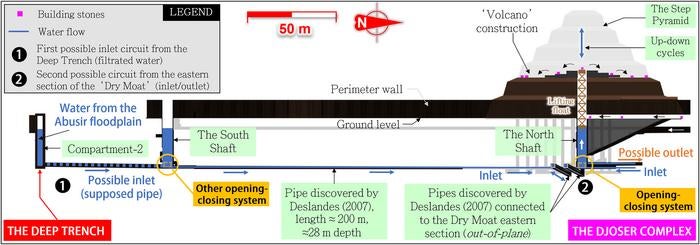Ancient Egyptians used hydraulic lifts to build first pyramids, controversial study claims
Not everyone is convinced by the theory
Your support helps us to tell the story
From reproductive rights to climate change to Big Tech, The Independent is on the ground when the story is developing. Whether it's investigating the financials of Elon Musk's pro-Trump PAC or producing our latest documentary, 'The A Word', which shines a light on the American women fighting for reproductive rights, we know how important it is to parse out the facts from the messaging.
At such a critical moment in US history, we need reporters on the ground. Your donation allows us to keep sending journalists to speak to both sides of the story.
The Independent is trusted by Americans across the entire political spectrum. And unlike many other quality news outlets, we choose not to lock Americans out of our reporting and analysis with paywalls. We believe quality journalism should be available to everyone, paid for by those who can afford it.
Your support makes all the difference.Egypt’s oldest pyramid was likely built with the help of an innovative hydraulic water elevator system, archaeologists claim in a new study which sheds more light on the ingenuity of ancient Egyptians.
The study, published on Monday in the journal PloS ONE, suggests water may have been flowing into two shafts located inside the Pyramid of Djoser, the oldest of Egypt’s iconic pyramids.
Also known as the Step Pyramid, the ancient Egyptian monument is thought to have been built around 2680 BCE as a funerary complex for the Third Dynasty pharaoh Djoser.
It was the first pyramid to be built and, standing at over 60m (200 ft) tall, it inspired the construction of larger pyramids in the following Fourth, Fifth, and Sixth Dynasties of ancient Egypt.
Contrary to previous monuments of the time which were made of mud brick, Djoser’s Step Pyramid is built using stone, and specifically limestone.

However, the exact methods used in its construction remain unclear.
Until now, there are no widely accepted explanations for how ancient Egyptians erected pyramids using millions of massive blocks each weighing over 2.5 metric tons.
Scholars have suspected ancient Egyptians used several techniques ranging from the use of pulleys, ramps, cranes, and rolling blocks onto logs to transport them to construction sites.
Now, researchers suspect water may have been key to helping raise and lower a float used to carry the stones, making the construction process relatively easy compared to earlier theories.
The new study suggests a previously unexplained nearby structure – the Gisr el-Mudir enclosure – likely functioned as a “check dam” to capture water and sediment.
Scientists say compartments dug into the ground outside of the pyramid may have served as a water treatment facility that allowed sediment to settle as water passed through each subsequent compartment.
This water could have then flown into the pyramid shafts where the force of its rise may have helped carry the building blocks, researchers suspect.
While there’s mounting archaeological evidence that ancient Egyptians used hydraulics in their irrigation canals, many scholars are not convinced there was enough water from sporadic rains to be used for a hydraulic system when the Step Pyramid was built.

Archaeologists call for further studies to understand if and how water might have flowed through the shafts.
They also hope to further assess how much water was likely available on the landscape at that point in Earth’s history.
While other building methods like ramps were also likely used, researchers say a hydraulic system may have complimented the pyramid-building process.
“It does seem logical to consider that the pyramid’s architects and overseers employed various construction techniques at their disposal, including ramps, lifting cranes, or animal force,” scientists wrote.
“Ancient Egyptians are famous for their pioneering and mastery of hydraulics through canals for irrigation purposes and barges to transport huge stones. This work opens a new line of research: the use of hydraulic force to erect the massive structures built by Pharaohs,” they said.

Join our commenting forum
Join thought-provoking conversations, follow other Independent readers and see their replies
Comments